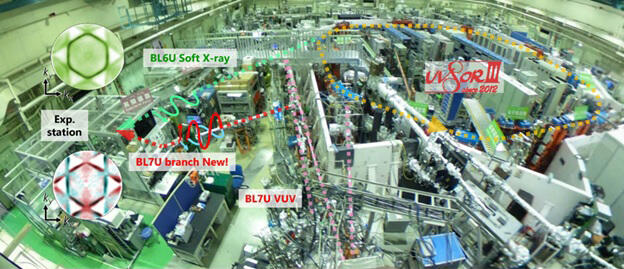The world's first experimental station that can apply synchrotron radiation from two beamlines to a single sample was created at the Institute for Molecular Science's Extreme Ultraviolet Light Research Facility (UVSOR). The station has been in operation since 1983 and is the second oldest active synchrotron radiation facility. Professor Fumihiko Matsui, Professor Satoshi Kera, Special Researcher (IMS Fellow) Kenta Hagiwara, Technical Staff Eiken Nakamura, Technical Staff Seiji Makita, Invited Professor Shigemasa Suga and Associate Professor Shinichiro Tanaka of the Institute of Scientific and Industrial Research at Osaka University developed this technology. The results have been published in the Journal of Synchrotron Radiation.

Provided by Professor Fumihiko Matsui's Group at the Institute for Molecular Science
A detailed understanding of the behavior of electrons in materials is important for developing new materials and devices, as well as for improving the properties of existing materials. One of the methods used for this is photoelectron spectroscopy. In 2020, UVSOR installed a photoelectron momentum microscope. This state-of-the-art photoelectron spectroscopy device allows us to observe the behavior of electrons in a microscopic region on the micrometer scale.
The research group has developed the world's first photoelectron momentum microscopy experimental station at UVSOR that can irradiate synchrotron radiation (vacuum ultraviolet light and soft X-rays) from two beamlines onto the same sample. By installing a new branch in the existing vacuum ultraviolet beamline BL7U, light from soft X-ray beamline BL7U can be irradiated and used directly in front of the sample surface at the photoelectron momentum microscope experimental station, where light from BL6U is used at oblique incidence on the sample surface. The combination of the two beamlines will make it possible to perform a photoelectron spectroscopy experiment using highly sensitive element-selective measurement with grazing incidence soft X-rays or highly symmetric measurement with direct incidence vacuum ultraviolet (VUV) light. In this experiment, it is possible to selectively perform one of the aforementioned types of measurement or perform them simultaneously.
By making full use of the degrees of freedom of this light source, a multifaceted analysis of electron behavior is achieved. In particular, UVSOR is the only photoelectron spectroscopy system in the world that is currently available in the direct-incidence configuration. It is a technology whose development was desired. Transition matrix element analysis using symmetry and polarization dependence of light in the direct incidence configuration allows direct access to atomic orbital information of valence band electrons. In addition, photoelectron momentum microscopy allows analysis of all photoelectrons that are ejected, bringing complete analysis of atomic orbitals closer to realization.
In the test, transition matrix element analysis was applied to the valence band dispersion of the Au(111) surface. The newly developed dual-beamline photoelectron momentum microscopy experimental station is the first of its kind in the world, and will enable the development of world-leading, original research. Further innovations in measurement technology are also expected. High-precision atomic orbital analysis of the valence band facilitates easier comparison with theoretical calculations. Advances in electronic structure research will lead to important insights that are directly related to not only condensed matter physics, molecular science, and materials science but also the development of fundamental properties and novel functions of materials.
Journal Information
Publication: Journal of Synchrotron Radiation
Title: Development of dual-beamline photoelectron momentum microscopy for valence orbital analysis
DOI: 10.1107/S1600577524002406
This article has been translated by JST with permission from The Science News Ltd. (https://sci-news.co.jp/). Unauthorized reproduction of the article and photographs is prohibited.




